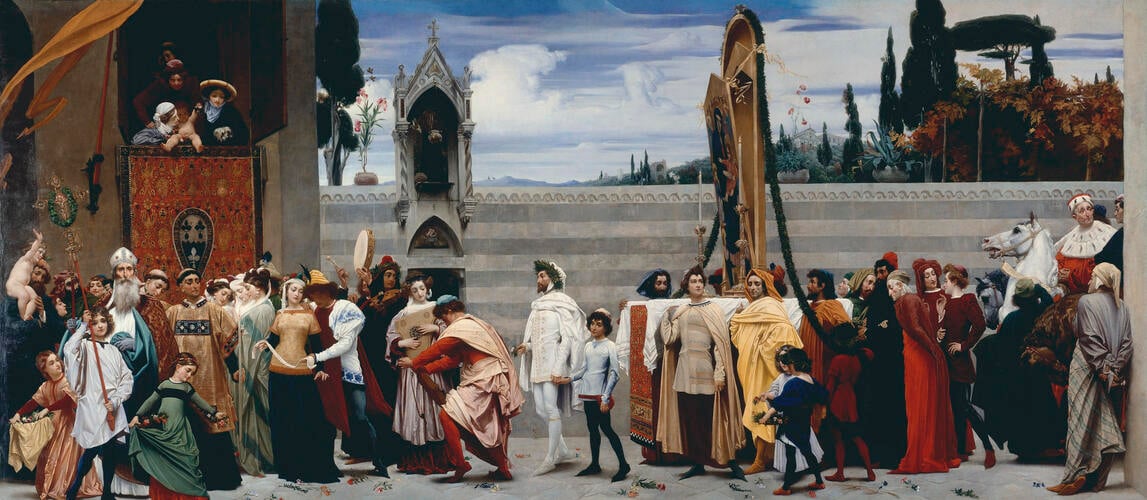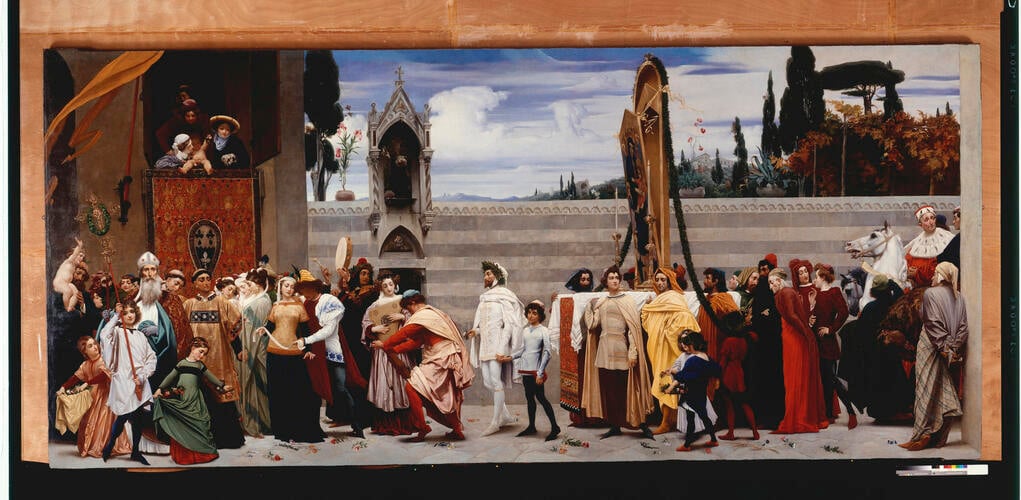-
1 of 253523 objects
Cimabue's Madonna Carried in Procession 1853-55
Oil on canvas | 231.8 x 521.4 cm (support, canvas/panel/stretcher external) | RCIN 401478
-
The altarpiece was commissioned in 1285 by a Dominican fraternity, the Company of Laudesi, and although Vasari attributed the panel to Cimabue it is now known to be by Duccio, who is named in the contract. In Leighton’s imaginative reconstruction Cimabue, wearing white and crowned with a laurel wreath, leads his pupil Giotto by the hand. On the far right Dante, leaning against a wall with his back to the viewer, watches the procession. The mounted figure bringing up the rear is probably King Charles of Anjou. Various other artists make up the rest of the crowd carrying the trestle upon which the altarpiece sits.
Following the translation of Vasari’s Lives into French in 1805, painters such as Ingres (Raphael and the Fornarina, 1814; Harvard, Fogg Art Museum) and Gérome began to present scenes from the lives of Renaissance artists, often stressing the quality of innate genius nurtured by a gifted master – as here with Cimabue and Giotto. The first English translation, by Mrs. Jonathan Foster, was not published until 1850-51, in five volumes.
Although born in Yorkshire, Frederic Leighton began his formal art education in Frankfurt at the Städelsches Kunstinstitut, first under J.D. Passavant then under Eduard von Steinle (see RCIN 408952). It was Steinle who instilled in his protégé an interest in the Middle Ages and early Italian art; his list of paintings that Leighton should see during a visit to Florence included works by Cimabue, Giotto, Masaccio, Uccello, Gozzoli, Ghirlandaio and Botticelli. It was also Steinle who suggested that Leighton first visit Rome, and who provided an introduction to Peter von Cornelius, one of the last of the Nazarene artists remaining in the city. The influence of the Nazarene tradition, with its careful depiction of nature, its interest in fresco and its reverence for the purity of early art, is evident in Cimabue’s Madonna.
The painting was Leighton’s first exhibit at the Royal Academy. Queen Victoria visited privately the day before the opening (Journal, 3 May 1855):
‘There was a very big picture, by a young man, called Leighton, his 1st attempt, at the age of 20…It is a beautiful painting quite reminding one of a Paul Veronese, so bright & full of lights. Albert was enchanted with it - so much so that he made me buy it. The young man’s father, said that his future career in life would depend on the success of this picture’.
The painting no doubt appealed to Prince Albert due to his interest in early Italian art, together with its highly finished surface and extraordinary attention to detail. Leighton made a large number of preparatory drawings for the painting, and consulted pattern books in an attempt to achieve historical accuracy in the costumes. The composition is carefully constructed in a geometric manner evocative of Renaissance principles of harmony, the wall in the background being two thirds the height of the wall. Cimabue and Giotto also cross hands at the precise horizontal centre point.
On its arrival at Buckingham Palace the painting was hung in the Music Room, adjacent to the Picture Gallery.
Signed centre left: FL (in monogram)
Text adapted from Victoria & Albert: Art & Love, London, 2010Provenance
Purchased by Queen Victoria at the Royal Academy Exhibition of 1855; recorded in the Music Room at Buckingham Palace in 1862
-
Creator(s)
Acquirer(s)
-
Medium and techniques
Oil on canvas
Measurements
231.8 x 521.4 cm (support, canvas/panel/stretcher external)
251.4 x 563.9 x 10.1 cm (frame, external)
Category
Object type(s)

